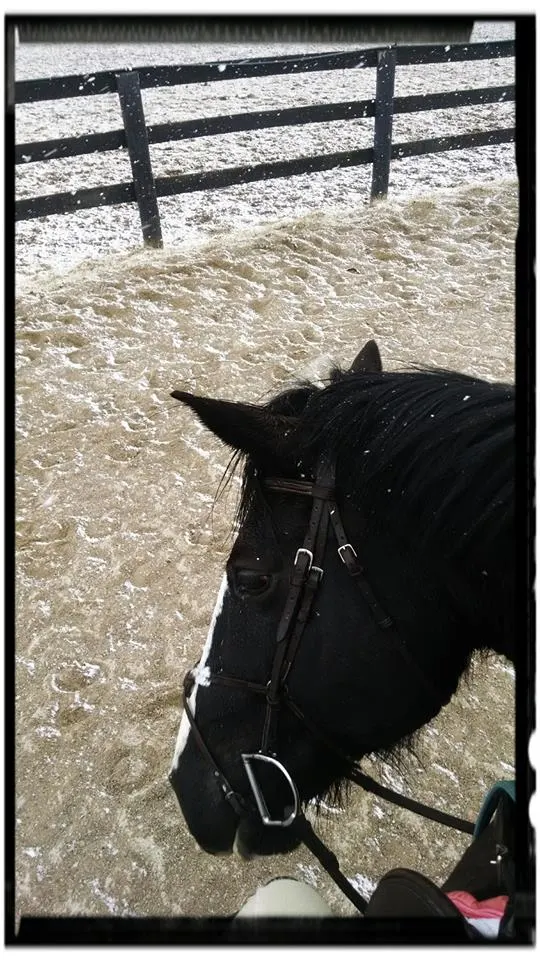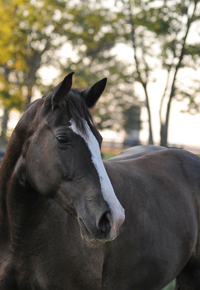I’m sure it will come as no surprise to devoted readers of my human management column that I don’t approve of vacations for Bipeds. In my experience with them, riders spend an absurd proportion of their time in the saddle trying to get out of significant work, so I’ve never understood what they need a break from, exactly. The Human seems to be in and out of town frequently in wintertime, and when she is here, she often complains that we cannot train because of petty considerations like ice, rain, or the arena surface being frozen.
Basically, despite my best efforts to get her some exercise (read: busting the fence and running around in the backyard of the farmhouse, or breaking the crossties and jogging to the hay storage area), December and January are pretty much a total wash. This means that every spring, I have to rebuild her arm and leg muscles, along with her courage. Fortunately for me, she’s not exactly a body builder even in the middle of the summer event season, so I don’t have but so far to go.

Each spring Jitterbug has to go through the painstaking process of getting her Human fit to compete once again after a long winter of refusing to ride in the cold and snow.
Most fitness-building guides I’ve read authored by Humans for Humans focus on “not overdoing it” early in the process. I think this attitude is feeble and defeatist, but of course when getting your biped back into shape, you do have to take care not to injure them by requiring too much. It’s not kind to give them stress injuries, but anything impacting their mobility slows the speed of your dinner delivery and probably means your cookie reserve will take a hit.
You’ll need to tailor your workout schedule to your Human’s discipline and individual fitness needs (fatness), but here’s a sample lesson plan from one of my conditioning rides.
• Humans seem to have the backwards impression that after a long layoff, it’s the quadruped who needs a longer-than-usual walk to warm up. In reality, the slow warm-up is engineered by the Human to gab with fellow boarders about how cold it is and how sure they are their calves will hurt later. Of course they will, Pipsqueak. Let’s get on with it.
The first five minutes are when I like to get the blood pumping ahead of the really important work. There are a couple of ways to do this, whether organically (by actually moving the body) or artificially (by increasing the heart rate without moving the body).
ADVERTISEMENT
If I’ve had my Wheaties, I accomplish organic circulation by jigging. I like to use about a 70/30 ratio of jigging to walking when the Human expects me to walk. Jigging is most effective if the Biped doesn’t know when it’s coming.
Artificial circulation can come from making the Biped nervous, which isn’t hard to do. I like to pick an item in the arena and suggest I find it suspicious. It doesn’t much matter which item you choose—a jump standard, a weed, a dog, a pole, the mounting block—what matters is your commitment to your stance. Look at the item sideways. Dance around the item. Hold your breath and exhale in one loud rhino snort.
You’ll notice the Biped’s heart rate increase from 60 to 120 in a matter of seconds.
• After a 10-minute warm-up, it’s time to begin trotting. This is where you have to be careful not to accidentally stress the Human too much too early. I have found it’s often difficult to keep track of how long you’ve been working a particular set of muscles. Time really flies when you’re snorting at buckets, and that rattle-rattle of her teeth when she tries (unsuccessfully) to sit the trot really lulls you into a sense of complacency.
To balance the workout, I like to switch the muscle groups I’m concentrating on. For one round of the arena, I might grit my teeth on the left side of my mouth to exhaust her biceps. Then I switch to my Saddlebred Wannabe trot for another round, which will exhaust her core. Try throwing a shoulder around one 20-meter circle and offering a neck bend for the next. Don’t forget to balance the process by performing the same tasks in both directions, and (if you are very talented), also backwards.
• When Humans lose muscle tone, they often lose some proprioception, too. Officially, this means they struggle to know without looking exactly where their body is positioned in space; in practice, I’ve found this means their elbows stick out, their heels stick up, their spurs (thankfully) tend to hit the saddle pad, and they sit too far forward in the saddle. Often, their fingers are also arranged incorrectly on the reins, their chests collapse in, and they spend an odd amount of time looking down at my mane instead of up between my ears. In other words, it means they have become more remedial students than they already were.
ADVERTISEMENT
Remind them to be sensitive to their positioning by frequently testing it. This may mean bucking, leaping or dancing sideways at the trot, and backing up instead of halting. Besides reminding Humans they have spaghetti noodles for legs, it also helps them realize when an arm or elbow is not where they thought they’d left it. Frequently, this discovery doesn’t come until the limb is headed for the ground, but we all must learn to fall sometime.
• If a Human is brave (or foolish) enough to ask for a short canter at the end of an early conditioning ride, this is not the time to go easy on them. It can be tempting to give in to the pleading they will almost certainly be doing by this time to, “Just be good?” But the problem with ending your session at the trot is that it does little to improve her aerobic capacity. Leaving this element of fitness unaddressed is how some Human managers end up with their Bipeds puking in the bushes at the end of a cross-country run, so it’s best to address it early.
I like to base my target speed for my canters on my racing counterparts. The first time out, you should expect to breeze a 40-meter circle in about 6-7 seconds. When the Human inevitably throws the reins at you out of horror, shoot for a 12-second lap around the arena, if your arena is the size of a standard dressage ring. Slow to a 5-second 20-meter circle at the end, when she panics and leans pathetically on one rein. Novice humans will try to half-halt throughout this jaunt, and while they will not be successful, this will add both cardio and core exercise to the end of your session.
• Don’t let the Human sit still after this workout, as the lactic acid build-up will stiffen her muscles. While I concede it is funny to watch her dismount onto her hiney when her legs give way, I’ve found letting her cramp up like this only prolongs her post-ride chores, and when that includes fetching my hard-earned dinner, I’m no longer amused.
 |
Jitterbug is a Michigan-bred Professional Draft Cross who skillfully avoided saddles until age 5. Since then, she has been lauded for her talent in successfully managing humans while training herself to one day achieve eventing greatness. Jitter and her human live in central Kentucky. Read all of Jitter’s COTH columns. Follow Jitterbug on Facebook! Photo by Dark Horse Photography. |














